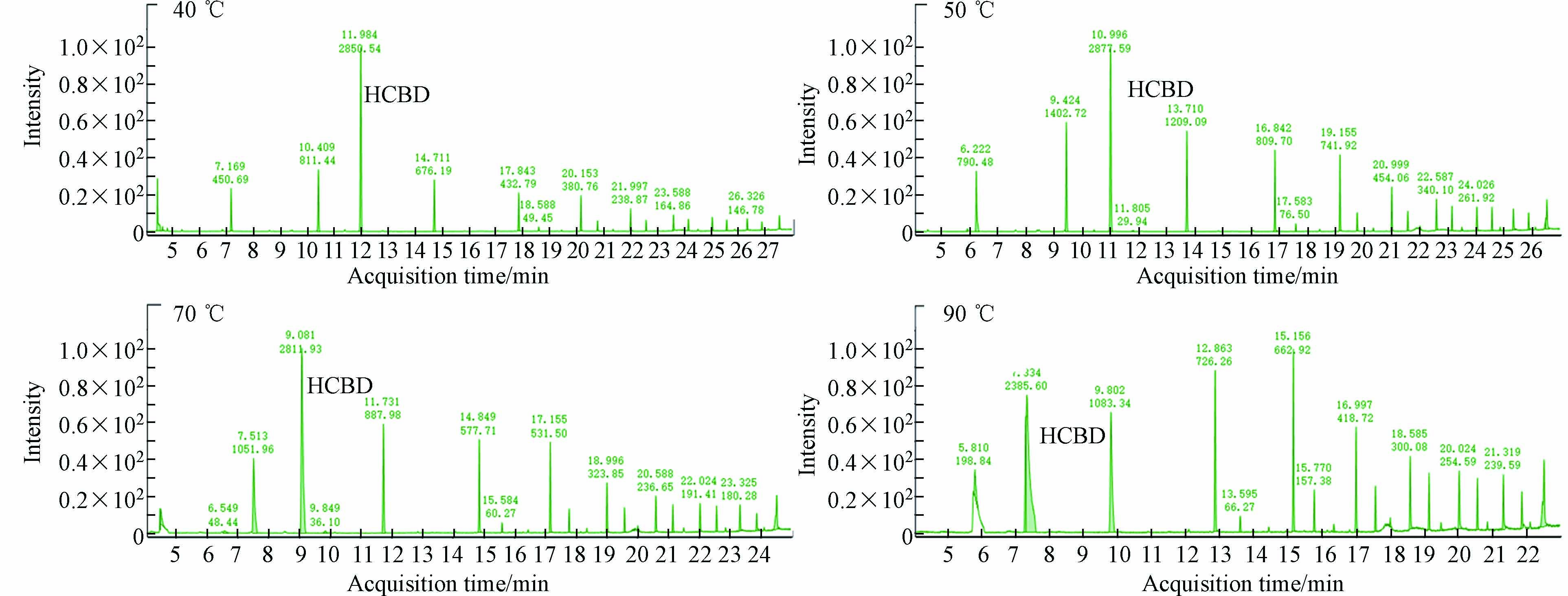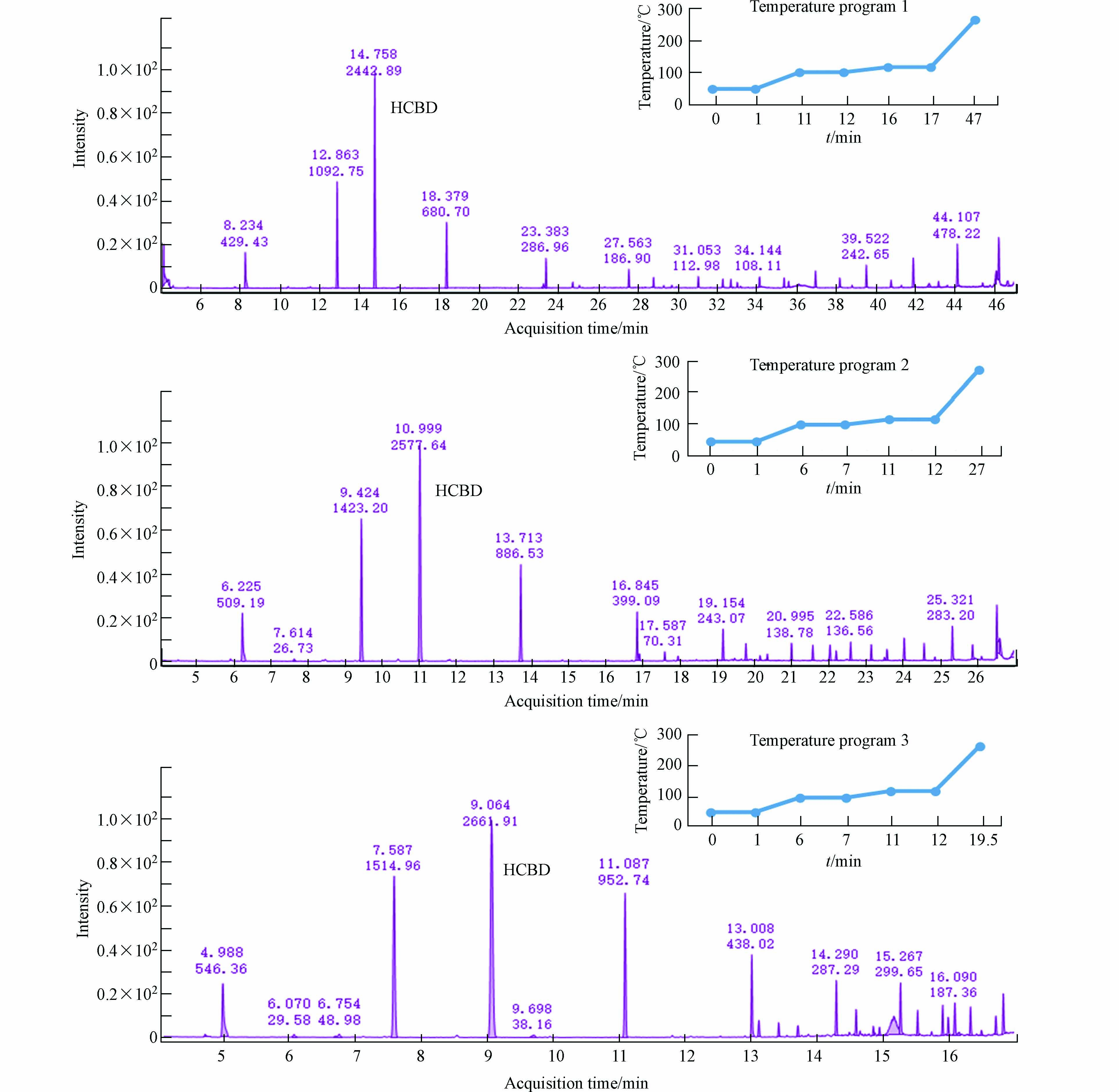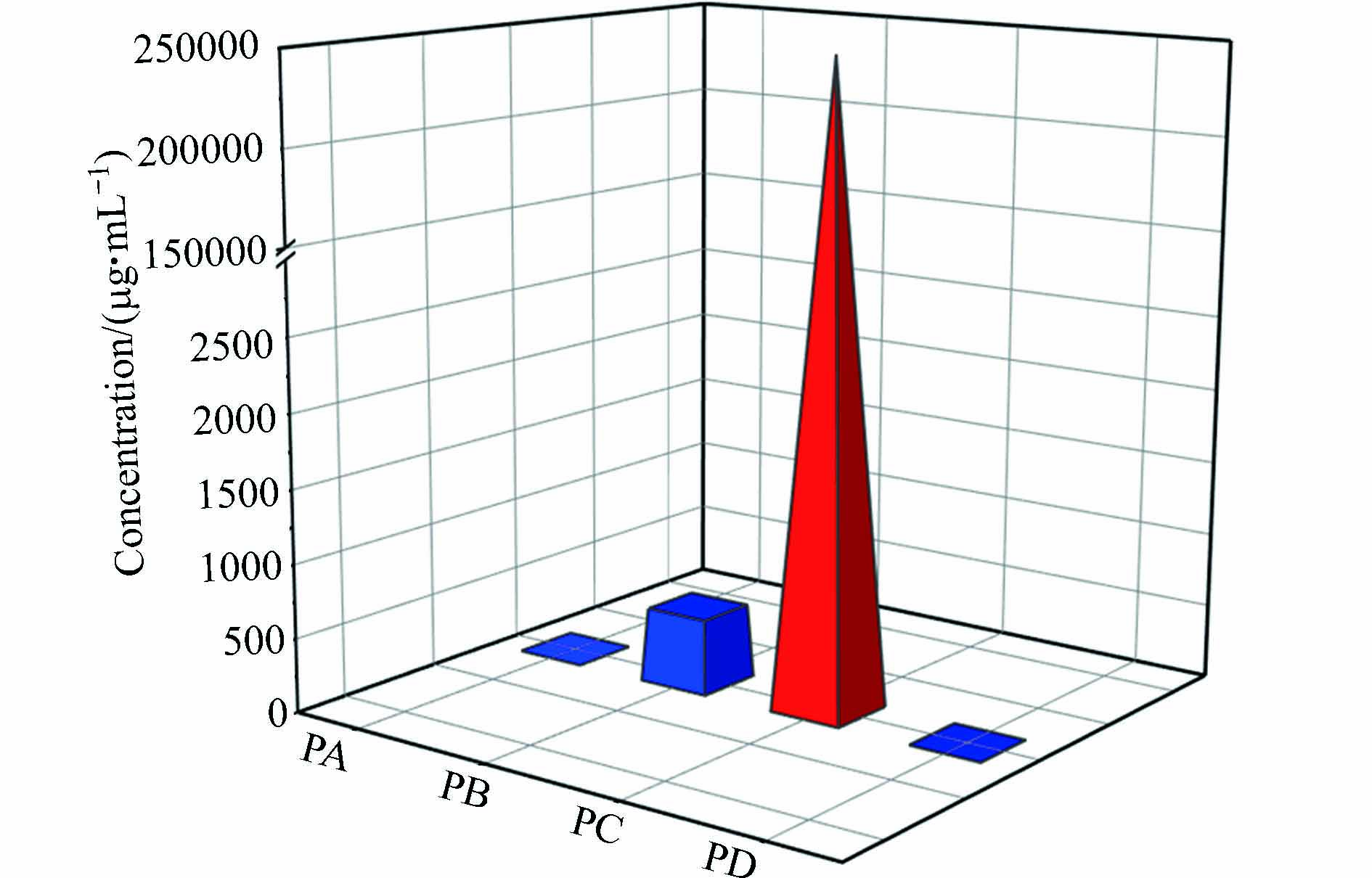-
六氯丁二烯(hexachlorobutadiene, HCBD)是一种卤代脂肪族化合物,于2017年被增列入斯德哥尔摩公约管控名单,是一类新持久性有机污染物(POPs). HCBD没有天然来源 [1 − 2],曾被广泛生产并应用于工业生产橡胶、传热液体、变压器、液压液体、杀虫剂、除草剂和杀菌剂 [1,3]. 欧洲于二十世纪七十年代末终止HCBD的有意生产和大部分使用. 1982年,全球HCBD的有意生产量估计为1 万t,而作为副产品无意产生的HCBD量要高得多,仅美国一国在含氯化学品生产过程中无意产生的HCBD就高达1.4 万t [4]. 氯碱化工等有机化工生产对工业无意生产HCBD总产量贡献为99%以上 [3 − 4]. 美国环保局(EPA)目前正在最终确定《有毒物质控制法》下的关于对持久性、生物累积性和有毒化学品的监管规则,提出在2021年3月8日之后,禁止所有在商业中制造、加工和分销HCBD和含HCBD的产品或物品,但以下情况除外:(1)氯化溶剂生产过程中作为副产物的HCBD的无意生产;(2)作为废燃料燃烧的HCBD的商业加工和分销 [5]. 鉴于氯化溶剂生产过程中极易产生HCBD副产物,氯化溶剂生产过程样品和氯化溶剂产品中的HCBD赋存现状尚不明确,对其赋存现状的认识对HCBD有效管控至关重要.
目前对于二噁英等斯德哥尔摩公约管控名单中典型POPs的分析检测方法已经比较成熟,有一些国际统一的标准分析方法,如用于二噁英分析的美国EPA的方法23、8280、1613、欧盟的EN1948等. 而对于HCBD等新POPs相关研究较少,并未形成统一的分析方法. 目前对HCBD的分析检测研究主要集中于水、土壤、污泥等环境介质,其研究方法也有所差异[6 − 8]. 现有研究的仪器检测方法主要有气相色谱-电子捕获检测(GC-ECD)、气相色谱-质谱检测(GC-MS)、气相色谱-串联质谱联用检测(GC-MS/MS)等. Chen等利用GC-MS/MS法首次报道了太原大气PM2.5中存在HCBD,平均浓度为3.69 pg·m−3,方法的回收率为87.4%—143% [9]. Fang等利用GC-ECD技术检测了污染场地土壤中的HCBD,浓度为0.02—0.37 ng·g−1[10]. 有研究应用GC-MS法分析了污泥和土壤样品中的HCBD [11],方法的加标回收率范围为51.3—119%,相对标准偏差小于15%,仪器检出限为0.015 ng·g−1,说明应用GC-MS分析方法检测环境介质中的HCBD是可行的. 有研究总结了环境中多种介质(如空气、水体、土壤、污泥、生物组织)中HCBD的分析方法 [12],提出GC-MS能很好的去除HCBD分析过程中干扰物质的影响,能够达到HCBD准确定性定量的标准,因此目前研究大多应用GC-MS法分析环境介质中的HCBD.
HCBD的主要排放源大多与化工生产有关,目前大部分研究都围绕化工生产厂周围的土壤、大气等环境样品中的HCBD展开研究,对化工生产过程中本身的化工产品或过程样品中HCBD的研究很少. 本研究将建立化工样品中HCBD的GC-MS分析检测方法,重点对化工生产过程,尤其是氯乙烯类化工样品中HCBD进行分析,以期为化工生产过程中HCBD的排放水平研究提供技术支撑,为化工行业HCBD的管理控制提供参考.
-
选取我国4家典型的氯乙烯、氯苯化工生产企业,采集了化工生产过程中不同工艺阶段的15个化工样品,包括原料样、中间产品样、釜底液样(指经精馏塔分离后留下的较高沸点的残液)、产品样. 原料样和产品样为纯度较高的液态化合物,中间产品样和釜底液样为多种有机化合物混合液. 准确称取1 mL样品,经硅胶-弗罗里硅土复合柱净化. 硅胶-弗罗里硅土净化柱(内径为2 cm)填料由下至上依次为玻璃棉、6 g弗罗里硅土、4 g活化硅胶和3 cm无水硫酸钠,上样前用70 mL正己烷预淋洗净化柱,加入样品后用150 mL正己烷洗脱,洗脱液通过旋转蒸发仪浓缩至约3 mL,采用氮吹仪浓缩至1 mL,样品转移至进样小瓶中. 由于釜底液等样品HCBD浓度较高,将其稀释了1000倍再上机检测. 本实验中13C4-HCBD标准样品购自剑桥同位素实验室(美国),正己烷等均为农残级溶剂,购自国药集团化学试剂有限公司. 弗罗里硅土和活性炭购自Sigma-Aldrich(美国),硅胶购自Merck(德国). 无水硫酸钠购自天津科密欧化学试剂有限公司. 采用气相色谱-质谱联用仪(Agilent 8890-5977B,美国)进行化工产品中HCBD的定性和定量分析.
采用HP-5MS(30 m×250 μm i.d.×0.25 μm)(Agilent,美国)色谱柱对HCBD和干扰物进行分离. 进样口温度、载气流速、升温程序等优化过程见下文. 接口温度为280 ℃,进样方式为不分流进样,采用恒流模式,柱流量为1.0 mL·min−1,碰撞气为氦气(流速为2.25 mL·min−1)和氮气(流速为1.5 mL·min−1). 采用EI源电离,电离能量为70 eV,四极杆温度为150 ℃. 使用多重反应监测模式(MRM)检测. 样品前处理过程中,每组样品分析的同时添加1个实验室空白样品,空白样品检测结果表明,目标物测定值均小于实际样品浓度的5%,说明实验室前处理过程对HCBD分析的干扰较小,实验结果可靠. 样品的最低检出限(LOD)以3倍信噪比(S/N)来计算,定量限(LOQ)以10倍信噪比计算. 对于低于检出限的样品数据本研究采用LOD的1/2来表示.
-
本方法设置了4个不同进样口温度,分别为180、230、280、300 ℃. 在4个进样口温度下对10 ng·mL−1的HCBD标准品进行GC-MS分析. 采集色谱图如图1所示,进样口温度从180 ℃升至280 ℃时,HCBD的响应逐渐增大;而从280 ℃再升高至300 ℃时,其响应又开始降低,这可能是因为温度过高导致HCBD降解,从而降低了响应. 进样口温度为180 ℃和300 ℃时流出的杂峰数量和峰响应明显高于进样口温度为280 ℃时的杂峰. 因此选择280 ℃为进样口温度.
探讨了0.8、0.9、1.0、1.1、1.2 mL·min−1 的5种载气流速对10 ng·mL−1浓度的HCBD标准品检测效果的影响. 当载气流速为1.0 mL·min−1时,获得的HCBD色谱峰峰面积和峰高均达到最大值,因此选择1.0 mL·min−1作为载气流速.
-
首先考察了不同的初始温度对目标物质分析的影响. 图2所示为40、50、70、90 ℃初始温度时化工产品中化合物的色谱峰,结果表明,初始温度为50 ℃时色谱峰的分离度和响应均优于40、70、90 ℃,且70 ℃和90 ℃时峰型明显变宽,分离度变差. 因此将升温程序的初始温度设为50 ℃.
其次考察了3种不同升温程序对目标物质分析的影响,升温程序1:初始温度50 ℃,保持1 min;以5 ℃·min−1升至100 ℃,保持1 min;以5 ℃·min−1升至120 ℃,保持1 min;以5 ℃·min−1升至270 ℃. 升温程序2:初始温度50 ℃,保持1 min;以10 ℃·min−1升至100 ℃,保持1 min;以5 ℃·min−1升至120 ℃,保持1 min;以10 ℃·min−1升至270 ℃. 升温程序3:初始温度50 ℃,保持1 min;以20 ℃·min−1升至100 ℃,保持1 min;以5 ℃·min−1升至120 ℃,保持1 min;以20 ℃·min−1升至270 ℃. 如图3所示,升温程序1和升温程序2下,色谱峰的分离度和峰型无明显的差异,而升温程序3下色谱峰变宽,分离度变差. 从分析时间来看,程序升温1、2和3的分析时间分别为47 min、27 min和17 min,考虑到分离效率和分析时间成本,选择升温程序2(图3).
-
对HCBD标准溶液进行全扫描(SCAN)分析,其色谱、质谱谱图如图4所示,提取每个色谱峰的质谱图后与NIST 14谱库进行检索比对,确定HCBD保留时间,同时根据质谱图选择质荷比大且响应较高的离子作为定性定量离子. HCBD的保留时间和特征离子如图4a所示. SCAN模式下干扰物质的杂峰较多,甚至有杂质峰响应高于目标物质峰,影响HCBD的定性定量分析. 进一步采用选择离子(SIM)分析,只扫描选定质量数的离子,很好的排除了其他离子干扰,极大的提高了检测的灵敏度(图4b). SIM模式下的谱图更加简单清晰,几乎无杂质峰影响,噪音干扰明显减少. 采用SIM模式扫描分析HCBD,HCBD定性离子和定量离子质量数分别为260(定性)、190(定性)和225(定量).
-
配制浓度梯度为0.1、1、10、50、100、300、500 ng·mL−1的HCBD标准溶液,绘制标准曲线(图5). HCBD的标准曲线相关系数R2 为0.9998,方法检出限(LOD)以3倍信噪比时的浓度计算,为0.049 ng·mL−1,定量限(LOQ)以10倍信噪比时的浓度计算,为0.16 ng·mL−1.
-
选取两个实验样品,在优化后的仪器参数下平行测定6次,1# 样品的平均浓度为1.72 ng·mL−1,相对标准偏差为1.4%;2# 样品的平均浓度为47.9 ng·mL−1,相对标准偏差为2.7%. 在空白样品中加入低(1 ng·mL−1)、中(50 ng·mL−1)、高(300 ng·mL−1)3个不同浓度的HCBD标准溶液,混匀后进行基质加标样品前处理和上机检测. 每个浓度水平的样品重复测定6次. 加标回收率为77.8%—102%,相对标准偏差为3.6%—6.0%. 加标回收率良好,可用于化工样品中HCBD的分析检测.
-
采集我国生产一氯苯(PA、PD)、三、四氯乙烯(PB、PC)的化工厂的原料、产品、釜底液等样品进行HCBD分析. 如图6所示,三、四氯乙烯生产过程中产生的HCBD浓度远高于氯苯生产过程,这与此前文献报道的三氯乙烯、四氯乙烯等化学品生产过程是HCBD的重要来源相一致 [1, 13-14]. 氯苯(PA、PD)化工厂样品中HCBD的浓度范围为0.0004—0.023 μg·mL−1,三氯乙烯(PB)化工厂HCBD的浓度范围是0.003—506 μg·mL−1,四氯乙烯(PC)化工厂HCBD的浓度范围是0.071—243000 μg·mL−1. 化工样品中HCBD的浓度水平由高到低依次为釜底液>中间产品>产品>原料. 釜底液样品中HCBD浓度最高,PB和PC化工厂釜底液样品中的浓度分别为506 μg·mL−1和243000 μg·mL−1. 这些研究结果将有助于识别化工生产中HCBD的来源,为实现HCBD有效管控、履行斯德哥尔摩公约提供数据支撑.
-
HCBD是一类新持久性有机污染物(POPs),目前关于化工生产过程中HCBD的赋存水平现状认识不清. 本研究建立了氯乙烯、氯苯等典型化工生产过程中HCBD的GC-MS分析方法,方法加标回收率为77.8%—102%,相对标准偏差小于6.0%,标准曲线相关系数R2为0.9998,方法检出限为0.049 ng·mL−1,定量限为0.16 ng·mL−1,能够满足化工样品中HCBD的准确定性和定量要求. 本研究将建立的GC-MS分析方法应用于我国氯乙烯、氯苯等典型化工生产过程中HCBD的检测分析,发现三、四氯乙烯生产过程中HCBD浓度远高于氯苯,浓度范围为0.003—243000 μg·mL−1.
随着我国氯代烃工业的发展,HCBD的无意生产量可能有所增加,其环境影响也将逐渐引起关注,氯乙烯等氯代烃生产过程中HCBD副产物的浓度和产量有待系统考察. 本方法的建立能够为化工生产工程中HCBD的排放水平研究和排放源识别提供技术支撑,为我国履行斯德哥尔摩公约,实现HCBD管控提供重要信息.
化工样品中六氯丁二烯的气相色谱-质谱分析方法
Analytical method for hexachlorobutadiene in chemical manufacturing samples by gas chromatography-mass spectrometrometry
-
摘要: 六氯丁二烯(hexachlorobutadiene,HCBD)已于2017年被增列入斯德哥尔摩公约管控名单,是一类新持久性有机污染物(POPs). 氯碱等化工生产过程能够无意产生HCBD副产物,是目前HCBD的主要来源,然而目前对于化工生产过程样品和化工产品中HCBD的研究较少,尚无完善的HCBD分析方法. 本研究建立了氯乙烯、氯苯等典型化工产品生产过程样品中HCBD的气相色谱-质谱(GC-MS)分析方法,优化了进样口温度、升温程序、载气流速等色谱参数,标准曲线线性范围为0—500 ng·mL−1,方法加标回收率为77.8%—102%,相对标准偏差为3.6%—6.0%,标准曲线相关系数R2为0.9998,方法检出限为0.049 ng·mL−1,定量限为0.16 ng·mL−1,能够满足化工样品中HCBD的准确定性和定量要求. 将建立的GC-MS分析方法应用于我国典型氯乙烯、氯苯等化工生产过程样品中HCBD的检测分析,发现三、四氯乙烯生产过程中HCBD浓度远高于氯苯,浓度范围为0.003—243000 μg·mL−1. 本方法的建立能够为化工生产过程中HCBD的排放研究提供技术支撑,为化工行业HCBD的源识别和管控提供重要信息.Abstract: Hexachlorobutadiene (HCBD) has been listed in Stockholm Convention in 2017, as a kind of emerging persistent organic pollutants (POPs). Chemical manufacturing processes such as chlor-alkali production can unintentionally produce HCBD as byproducts, which is considered as the main source of HCBD at present. Current HCBD related studies mainly focused on environmental samples such as soil and atmosphere surrounding chemical production plants. However, few studies has been conducted on HCBD occurrences in chemical products or chemical residues during the chemical manufacturing processes. This study established a gas chromatography-mass spectrometry (GC-MS) method for the analysis of HCBD in chemical manufacturing samples such as chloroethylene and chlorobenzene. The chromatographic parameters containing inlet temperature, heating procedure and carrier gas flow rate were optimized. The linear range of the standard curve is 0—500 ng·mL−1. The recoveries of the method were 77.8%—102%, and the relative standard deviations were 3.6%—6.0%. The correlation coefficient R2 of the standard curve was 0.9998. The detection limit was 0.049 ng·mL−1, and the limit of quantification was 0.16 ng·mL−1, which could meet the accurate qualitative and quantitative requirements of HCBD in chemical samples. The established GC-MS analysis method was then applied to the analysis of HCBD in practical chemical samples from typical chloroethylene and chlorobenzene manufacturing processes in China. It was found that the concentration of HCBD in the production of trichloroethylene and tetrachloroethylene (0.003—243000 μg·mL−1) was much higher than that of chlorobenzene. The method can provide technical support for the study of HCBD emission in the chemical production process, and provide important information for their source identification and emission control.
-

-
-
[1] LECLOUS A. Hexachlorobutadiene – Sources, environmental fate and risk characterisation [M]. Brussels, Belgium: Euro Chlor, 2004: 7. [2] 韩余, 田琳, 唐阵武. 六氯丁二烯的来源、环境分布及其生态风险研究进展[J]. 环境污染与防治, 2019, 41(2): 216-223. doi: 10.15985/j.cnki.1001-3865.2019.02.018 HAN Y, TIAN L, TANG Z W. Research progress in distributions, sources and ecological risks of hexachlorobutadiene[J]. Environmental Pollution & Control, 2019, 41(2): 216-223(in Chinese). doi: 10.15985/j.cnki.1001-3865.2019.02.018
[3] BELOVA E V, DZHIVANOVA Z V, TKHORZHNITSKY G P, et al. The effect of irradiation with accelerated electrons on the extraction of Pu with 30% solution of TBP in Isopar-M[J]. Progress in Nuclear Energy, 2017, 94: 202-207. doi: 10.1016/j.pnucene.2016.04.015 [4] WANG L, BIE P, ZHANG J B. Estimates of unintentional production and emission of hexachlorobutadiene from 1992 to 2016 in China[J]. Environmental Pollution, 2018, 238: 204-212. doi: 10.1016/j.envpol.2018.03.028 [5] U. S. Environmental Protection Agency. Hexachlorobutadiene (HCBD);regulation of persistent, bioaccumulative, and toxic chemicals under TSCA section 6(h)[J]. The Federal Register / FIND, 2021, 86(003): 922-932. [6] LIU L H, ZHOU H D. Investigation and assessment of volatile organic compounds in water sources in China[J]. Environmental Monitoring and Assessment, 2011, 173(1): 825-836. [7] 张利飞, 杨文龙, 薛令楠, 等. 四氯乙烯生产企业周边空气中六氯丁二烯的污染特征[C]. 持久性有机污染物论坛暨第十一届持久性有机污染物国际学术研讨会, 2016. [8] ZHANG H Y, JIANG L, ZHOU X, et al. Determination of hexachlorobutadiene, pentachlorobenzene, and hexachlorobenzene in waste incineration fly ash using ultrasonic extraction followed by column cleanup and GC-MS analysis[J]. Analytical and Bioanalytical Chemistry, 2018, 410(7): 1893-1902. doi: 10.1007/s00216-018-0849-5 [9] CHEN Y J, ZHANG Y H, CHEN Y Y, et al. GC-MS/MS analysis for source identification of emerging POPs in PM2.5[J]. Ecotoxicology and Environmental Safety, 2020, 193: 110368. doi: 10.1016/j.ecoenv.2020.110368 [10] FANG Y Y, NIE Z Q, DIE Q Q, et al. Organochlorine pesticides in soil and air at and around a compound contaminated site: Vertical distribution, soil-air exchange and risk evaluation[J]. Stochastic Environmental Research and Risk Assessment, 2018, 32(4): 1179-1188. doi: 10.1007/s00477-017-1412-1 [11] 张海燕. 新型卤代有机污染物六氯丁二烯、多氯萘的环境赋存和全氟化合物膳食暴露的初步研究[D]. 北京: 中国科学院大学, 2014. ZHANG H Y. Preliminary study on environmental occurrence of new halogenated organic pollutants HCBD and PCN and dietary exposure of perfluorocompounds[D]. Beijing: University of Chinese Academy of Sciences, 2014(in Chinese).
[12] 王尧天, 张海燕, 史建波, 等. 六氯丁二烯分析方法研究进展[J]. 色谱, 2021, 39(1): 46-56. doi: 10.3724/SP.J.1123.2020.05019 WANG Y T, ZHANG H Y, SHI J B, et al. Research progress on analytical methods for the determination of hexachlorobutadiene[J]. Chinese Journal of Chromatography, 2021, 39(1): 46-56(in Chinese). doi: 10.3724/SP.J.1123.2020.05019
[13] ZHANG H Y, SHEN Y T, LIU W C, et al. A review of sources, environmental occurrences and human exposure risks of hexachlorobutadiene and its association with some other chlorinated organics[J]. Environmental Pollution, 2019, 253: 831-840. doi: 10.1016/j.envpol.2019.07.090 [14] UNEP. Report of the persistent organic pollutants review committee on the work of its ninth meeting: Risk management evaluation on hexachlorobutadiene. Draft 2013. UNEP/POPS/POPRC. 9/13/Add. 2[R]. United Nations Environment Programme, Rome, 2013. -




 下载:
下载:






